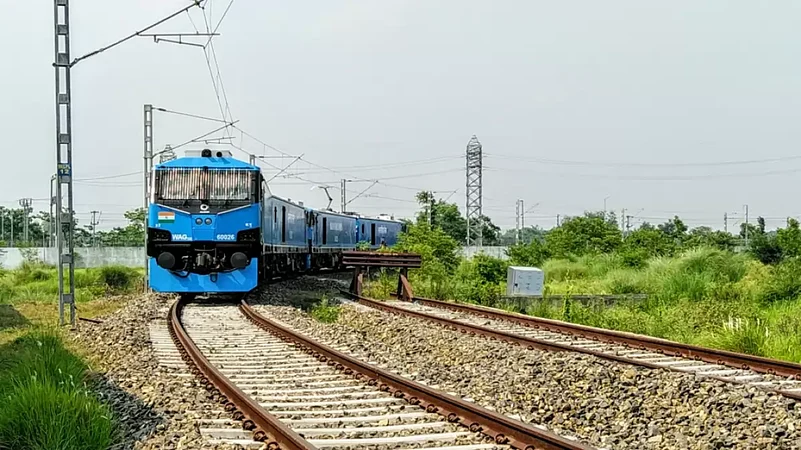The Railway Budget was merged with the Union Budget during 2017-18 to synchronize railway policies with broader economic strategies, focus on capacity expansion, safety & technology, efficient fund allocation, and decision-making. Since then, the Ministry of Railways capex increased at a CAGR of 24 per cent during FY17-25BE to Rs 2.5 trillion. Today, India has the fourth-largest railway network in the world with 68,907 route km (rkm) with rail electrification at 97 per cent which is far ahead of top three countries like the USA, China, and Russia.
However, 53 per cent of routes in India carry 96 per cent of the traffic, leading to lower average speed of 22km/hour due to congestion. Due to a lack of transit assurance, railways' share in India’s freight mix fell to 26 per cent vs 86 per cent in the 1950s, losing market share to roads at 60 per cent, which has the highest cost per tonne per km of Rs 2.5 vs railways at Rs 1.5. Developed nations like the USA, China, and the European Union (EU) region do not have more than 45 per cent share of cargo on the road. This impacts India’s logistics cost at 10 per cent of GDP vs developed nations at 8 per cent and the Logistics Performance Index Rank at 38 out of 139 countries. Hence, in the current situation, three burning priorities for the Railways are as follows: 1) capex and infrastructure upgradation for economic and environment benefits, 2) realigning the cargo modal mix for lower cost & faster turnaround time, and 3) technology and innovation.
Advertisement
Pays to Grow Big: Infrastructure and Capacity Expansion
With a stable government in place, India will accelerate its vision of a Viksit Bharat by 2047, the centenary of Independence. The government is geared up to create a future-ready railways system with envisaged spend of more than RS 38 trillion during FY21-51 and additional leverage through private sector participation, as per the National Rail Plan. Key focus areas laid out in the 2024-25 Interim Union Budget include: 1) energy, metal, cement corridor, 2) port-rail connectivity, 3) 40,000km of new tracks in the next 6-8 years, 4) redevelopment of 553 stations, 5) upgrade 40,000 coaches and develop 10,000 new coaches, 6) new Dedicated Freight Corridors (DFC), High Speed Rail and India-Middle East-Europe (IMEC) multi-modal transport corridor.
Advertisement
We believe the government will enhance focus in the upcoming Full Union Budget on 23 July with higher capex allocation at Rs 11.4-11.5 trillion vs RS 11.1 trillion budgeted in the Interim Budget, which would be 3.5 per cent of nominal GDP.
Realigning Cargo Modal Mix
On the back of major infrastructure development and favorable government policy reforms, such as the GST, eWay bill, and FASTag; logistics costs may have reduced to 10.5 per cent of GDP currently from 13 per cent in FY19. With the ongoing initiatives, as per our Parivartan 2024 study, the cost is set to further reduce to 8 per cent in the next 4-5 years, led by:
20 per cent - Improving modal split and inventory management to achieve the optimum outcome
4-10 per cent - optimized cost + sustainable alternatives (LNG trucks, bio-diesel, ethanol blend)
3 per cent - enhanced productivity leading to faster turnaround time (digitalization, DFC & quality infra)
This would ease the capacity for new passenger trains, which, in turn, reduce wait times and improve quality of services. Currently, Indian Railways operate more than 13,000 passenger trains carrying 23 million passengers and more than 9,000 freight trains carrying 3 million tonnes everyday across 7,000 stations.
Technology and Innovation at the Forefront
Railways increasingly need to create indigenous technology to deliver smart solutions to tackle challenges related to safety, connectivity, and sustainability. Gati Shakti is to play a crucial role in creating a Mega Masterplan worth $1.2 trillion for multi-modal connectivity to provide a competitive advantage for manufacturing in India. A digital platform has been created to combine 16 ministries for integrated planning and coordinated implementation of projects. Also, as part of the “Startups for Railways” initiative, the Indian Railways Innovation Portal addresses areas of designing, rail stress monitoring systems, track inspection technologies, and sensor-based load counting devices. Further, the Indian Railways is among the few railway systems globally to commit to achieving net zero carbon emissions by 2030.
Advertisement
Huge Opportunity Across the Value Chain
In the past decade, the railways sector aggregate earnings increased at a CAGR of 15 per cent while the market cap addition rose 42 per cent.
With a large opportunity landscape and potential GDP multiplier of 5x, the sector is likely to see continued traction with key beneficiary companies being:
1) Engineering consultants
2) EPC contractors
3) Components suppliers
4) Rail cargo operators
India’s railway sector remains in a superfast mode with projects not just in India but also internationally taking our 171-year rich experience globally.
(Ankita Shah is Vice President - Equity Research at Elara Capital. Views expressed are authors alone)















 Just one email a week
Just one email a week